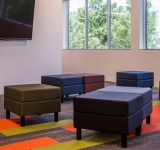
How To Promote Good Break Room Behavior
Many companies provide employees with a break room, where they can relax and grab a snack or eat a meal before returning to work after the end of their break or meal period.
The purpose of a breakroom is to help increase employee morale and employee retention, but without proper breakroom etiquette, problems between employees and even between employees and supervisory personnel may arise. Here’s how to create an ideal break room with employee comfort and comradery in mind.
Why is an etiquette policy needed?
You may think that gainfully employed people wouldn’t “raid the company fridge,” but studies show 1 in 5 people do so. And that includes office supervisors and managers, by the way.
We won’t cover the many reasons why “fridge theft” and other bad behaviors occur – our goal in this blog is to help you minimize these bad behaviors as much as possible.
Here’s What You Can Do To Help Employees Enjoy The Break Room
-
Design a comfortable breakroom

Regardless of how many break rooms you have, each one should be designed to allow employees to feel comfortable. Dingy green plastic chairs and cheap plastic tables don’t do much for the ambiance of a break room or the comfort of its users. ROSI office furniture is sturdy, attractive, and comfortable.
Keep in mind, too that your break room will probably be used for small informal meetings when planning the design. Quiet corners are the perfect location for banquette seating and larger tables for such occasions.
-
Dealing with unwanted noise
Some people can tune out music or TV babble they don’t want to hear, but others can’t, and it results in stress.
If you have a TV in a small break room, have the sound off and captions on. That way people who wish to read or chat will not be disturbed by the noise of the TV, and those who want to watch TV can still enjoy it.
Have a policy that no boom boxes are allowed and anyone listening to music or playing games on their phones must wear earbuds.
Label one corner of the room a “quiet area,” and have “no talking” signs posted. This way, people who wish to eat and read a book can do so, while those individuals who like conversation will seek out others of the same mind.
-
Food etiquette
Refrigerator
If you provide a refrigerator, list a series of policies in large print on the door.
Here’s a sample checklist:
- All food must be in a container. The container must be labeled with the owner’s name and the date it was placed in the fridge.
- Food that is not in a container will be tossed after 24 hours.
- All food containers will be tossed 3 – count them, 3 – days after the date on the container — NO EXCEPTIONS.
- Please label drinks as well, to prevent any misunderstandings. Beverages can remain in the refrigerator indefinitely.
- Spills in the fridge? Please clean it up!
Some individuals live check-to-check. After they’ve paid all their bills, they may have little left over for food. This has been cited as one reason for “fridge theft.” Perhaps institute a “Healthy snack sample table” so that people can help themselves to food if they need it. Have a donation box secured to the table and equipped with a lock, so that people can pay what they can when they can to replenish the snacks. Assign an individual to monitor the snack table and replace when necessary.
Microwave
If you offer a microwave, list a series of policies in large print right above the machine. Here’s a sample checklist:
- Please cover your food, so it doesn’t splatter
- If your food does splatter, please clean it up
Foods with strong aromas can be bothersome to certain individuals. Give reasons why you request some foods not be brought to work so that the rules sound reasonable and not like strict commands.
- Some aromas penetrate and can be unpleasant to others. Please, no popcorn, curries, or fish dishes.
And finally, a blanket list of requested behaviors.
- Need to move a table? Please put it back in position when done.
- Please clean any spills on the tables and place your garbage in the trash bins.
By having a clearly defined Break room etiquette policy along with an optimal layout, you’ll be able to prevent problems before they begin, or at least minimize them.
This will contribute to a pleasant work environment and help increase employee productivity as well as retention.
Here is one of our favorite break rooms/employee lounge. Let us know if you need help creating one of your own.

John Ofield is a recognized expert in the office furniture and office cubicle industry, with over 40 years of experience. As the founder of ROSI Office Systems, he specializes in space planning, custom cubicle designs, and high-quality commercial furniture. John’s expertise helps businesses enhance productivity and collaboration. He is also dedicated to mentoring entrepreneurs and redefining workspaces to inspire success.





